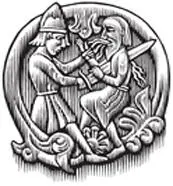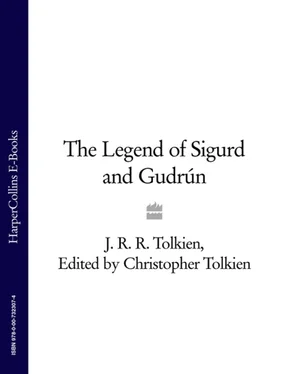J. Tolkien - The Legend of Sigurd and Gudrún
Здесь есть возможность читать онлайн «J. Tolkien - The Legend of Sigurd and Gudrún» — ознакомительный отрывок электронной книги совершенно бесплатно, а после прочтения отрывка купить полную версию. В некоторых случаях можно слушать аудио, скачать через торрент в формате fb2 и присутствует краткое содержание. Жанр: Старинная литература, на английском языке. Описание произведения, (предисловие) а так же отзывы посетителей доступны на портале библиотеки ЛибКат.
- Название:The Legend of Sigurd and Gudrún
- Автор:
- Жанр:
- Год:неизвестен
- ISBN:нет данных
- Рейтинг книги:5 / 5. Голосов: 1
-
Избранное:Добавить в избранное
- Отзывы:
-
Ваша оценка:
- 100
- 1
- 2
- 3
- 4
- 5
The Legend of Sigurd and Gudrún: краткое содержание, описание и аннотация
Предлагаем к чтению аннотацию, описание, краткое содержание или предисловие (зависит от того, что написал сам автор книги «The Legend of Sigurd and Gudrún»). Если вы не нашли необходимую информацию о книге — напишите в комментариях, мы постараемся отыскать её.
The Legend of Sigurd and Gudrún — читать онлайн ознакомительный отрывок
Ниже представлен текст книги, разбитый по страницам. Система сохранения места последней прочитанной страницы, позволяет с удобством читать онлайн бесплатно книгу «The Legend of Sigurd and Gudrún», без необходимости каждый раз заново искать на чём Вы остановились. Поставьте закладку, и сможете в любой момент перейти на страницу, на которой закончили чтение.
Интервал:
Закладка:
In Guðrúnarhvöt Gudrún tells that she attempted to drown herself in the sea, but the waves cast her up (as in the Lay of Gudrún 158), and her story was not ended. Early on, a wholly distinct and very ancient Gothic legend was threaded on to the acquisitive Niflung theme. This legend concerned the death of the Ostrogothic king Ermanaric (see note to 86) at the hands of two brothers, in revenge for the murder of their sister; and the sister, Swanhild ( Svanhildr ), became the wife of Ermanaric and the daughter of Sigurd and Gudrún, her brothers (Hamðir and Sörli) the sons of Gudrún by her third and last marriage to a shadowy king named Iónakr.
Earlier in the Lay of Gudrún, when Gunnar sang of ancient Gothic deeds (86), he named Iormunrek (Ermanaric); and this of itself shows that my father was cutting away the Gothic legend from his Niflung poem, and setting Iormunrek in a historical context – for in history Ermanaric died some sixty years before Gundahari (Gunnar) king of the Burgundians.
Only in Guðrúnarhvöt is there any reference in Norse literature to the manner of Gudrún’s death (self-destruction on a funeral pyre); but in the Lay of Gudrún she utters her lament, and again giving herself to the waves is this time taken.
APPENDICES

APPENDIX A
A short account of the
ORIGINS OF THE LEGEND
§ I Attila and
Gundahari
In both Lays my father used the expression ‘Borgund lord(s)’, chiefly in reference to Gunnar, or Gunnar and Högni (who are also called ‘Gjúkings’ and ‘Niflungs’). In the commentary on the Lay of the Völsungs, VII.15, I have explained that he derived the name ‘Borgund’ from a single occurrence in Atlakviða of the title vin Borgunda ‘lord of the Burgundians’, applied to Gunnar, and that nowhere else in Norse literature was Gunnar remembered as a Burgundian. In this title appears one of the chief elements in the legend.
The Burgundians were in origin an East Germanic people who came out of Scandinavia; they left their name in Bornholm (Norse Borgunda holm ), the island that rises from the Baltic south-east of the southern tip of Sweden. In the Old English poem Widsith they are named together with the eastern Goths (Ostrogoths) and the Huns: ‘Attila ruled the Huns, Ermanaric the Goths, Gifica the Burgundians’, which may be taken to be a memory of a time when the Burgundians still dwelt in ‘East Germania’; but they moved westwards toward the Rhineland, and it was there that disaster overtook them.
Early in the fifth century they were settled in Gaul, in a kingdom on the west bank of the Rhine centred on Worms (south of Frankfurt). In the year 435, led by their king Gundahari, the Burgundians, impelled as it seems by the need for land, embarked on an expansion westwards; but they were crushed by the Roman general Aetius and forced to sue for peace. Two years later, in 437, they were overwhelmed by a massive onslaught of the Huns, in which Gundahari and a very large number of his people perished. It has been commonly supposed that the Roman Aetius, whose primary purpose was to defend Gaul from the encroachments of the barbarians, called in the Huns to destroy the Burgundian kingdom of Worms. There is no reason to suppose that Attila was the leader of the Huns in this battle.
But the Burgundians of the Rhineland were not wholly destroyed in 437, for it is recorded that in 443 the survivors were allowed to settle as colonists in the region of Savoy. A curious glimpse of them is found among the writings of Sidonius Apollinaris, a cultivated Gallo-Roman aristocrat, Imperial politician, and poet, born in Lyons about 430, and in his later years the bishop of Clermont, the chief city of the Auvergne. He left in his letters a portrait of the manners and mode of life in the strange society of southern Gaul in the fifth century.
But to the fastidious Sidonius the gross Burgundians were repellent and their culture wholly without interest. In a satirical poem he complained humorously of having to sit among the long-haired barbarians (who were excessively fond of him) and be forced to endure Germanic speech: to praise with a wry face the songs sung by the gluttonous, seven foot tall Burgundians, who greased their hair with rancid butter and reeked of onions. Thus we learn nothing from him of the songs which were sung by the contemporaries of Gundahari and Attila, but only that his own muse fled away from the noise.
That they preserved their traditions, however great the disaster of 437, is suggested by a Burgundian code of laws drawn up King Gundobad not later than the early sixth century, in which the names of ancestral kings are cited: Gibica, Gundomar, Gislahari, Gundahari. These names all appear in later legend, though it cannot be known what were the historical relationships between them. Gundahari is Gunnarr (vin Borgunda) in Norse. He appears in Old English in the very dissimilar but ultimately identical form Guðhere : in the poem Widsith the minstrel says that when he was ‘among the Burgundians’
me þær Guðhere forgeaf glædlicne maððum
songes to leane; næs þæt sæne cyning.
(‘there Guðhere gave me a glorious jewel in reward for my song: he was no sluggish king.’) In the German tradition he is Gunther.
Gibica , in the form Gifica , appears in the Old English Widsith as the ruler of the Burgundians together with the rulers of the Goths and the Huns, as I have mentioned above. In Norse the name became by regular phonetic change Gjúki , who is the father of Gunnar; in forms of the German tradition Gibeche is likewise the father of Gunther; but (especially in view of the placing of Gifica in Widsith ) it may be that he was in history an illustrious ancestor of an older time.
‘It is easy to understand,’ wrote R.W. Chambers in his edition of Widsith (1912) ‘why the story of the fall of Gundahari and his men in battle against the Huns was of interest not merely to the Burgundian, but to all his neigh-bours, till, as the centuries passed, it became known from end to end of Germania. Eight centuries after his fight Gundahari was still remembered from Iceland to Austria.’
With this view my father did not altogether concur. In notes for lectures primarily on the knowledge of the Völsung legend among Old English poets, he said: ‘Guðhere’s tale is one of downfall after glory – and sudden downfall, not slow decay – sudden and overwhelming disaster in a great battle. It is the downfall, too, of a people that had already had an adventurous career, and disturbed things in the west by their intrusion and by the rise of a considerable power at Worms. It is easy to see how their defeat by Aetius only two years previously would be telescoped in the dramatic manner of legend into the defeat by the Huns (if not actually connected in history, as it may have been).
‘Guðhere, already valiant and a generous goldgiver as patron in Widsith , must have been very renowned . Mere downfall, without previous glory, did not excite minstrels to admiration and pity. However, we are probably not far wrong in guessing that there must – quite early – have been some other element than mere misfortune in this tale to give it the fire and vitality it clearly had: living as it did down the centuries. What this was we can hardly guess. Gold? It may well have been that gold, or the acquisition of some treasure (that later still became connected with some renowned legendary gold) was introduced to explain Attila’s attack. Attila (when legend or history is not on his side) is represented as grasping and greedy. It may have been in this way that Guðhere ultimately got connected with the most renowned hoard, the dragon’s hoard of Sigemund [in Old English], of Sigurd [in Old Norse].’
Читать дальшеИнтервал:
Закладка:
Похожие книги на «The Legend of Sigurd and Gudrún»
Представляем Вашему вниманию похожие книги на «The Legend of Sigurd and Gudrún» списком для выбора. Мы отобрали схожую по названию и смыслу литературу в надежде предоставить читателям больше вариантов отыскать новые, интересные, ещё непрочитанные произведения.
Обсуждение, отзывы о книге «The Legend of Sigurd and Gudrún» и просто собственные мнения читателей. Оставьте ваши комментарии, напишите, что Вы думаете о произведении, его смысле или главных героях. Укажите что конкретно понравилось, а что нет, и почему Вы так считаете.












